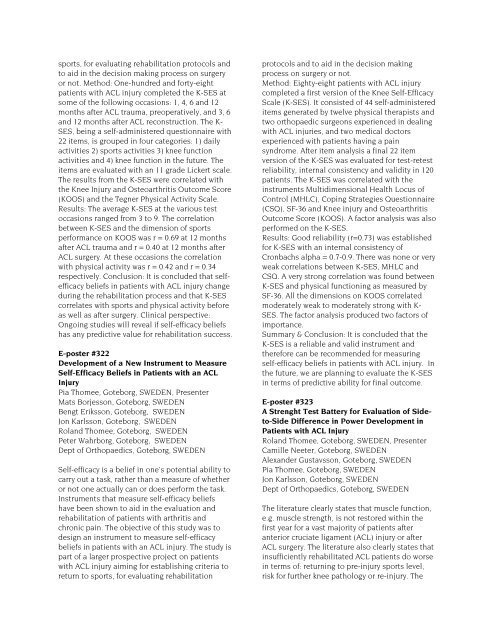POSTER ABSTRACTS - ISAKOS
POSTER ABSTRACTS - ISAKOS
POSTER ABSTRACTS - ISAKOS
Create successful ePaper yourself
Turn your PDF publications into a flip-book with our unique Google optimized e-Paper software.
sports, for evaluating rehabilitation protocols and<br />
to aid in the decision making process on surgery<br />
or not. Method: One-hundred and forty-eight<br />
patients with ACL injury completed the K-SES at<br />
some of the following occasions: 1, 4, 6 and 12<br />
months after ACL trauma, preoperatively, and 3, 6<br />
and 12 months after ACL reconstruction. The K-<br />
SES, being a self-administered questionnaire with<br />
22 items, is grouped in four categories: 1) daily<br />
activities 2) sports activities 3) knee function<br />
activities and 4) knee function in the future. The<br />
items are evaluated with an 11 grade Lickert scale.<br />
The results from the K-SES were correlated with<br />
the Knee Injury and Osteoarthritis Outcome Score<br />
(KOOS) and the Tegner Physical Activity Scale.<br />
Results: The average K-SES at the various test<br />
occasions ranged from 3 to 9. The correlation<br />
between K-SES and the dimension of sports<br />
performance on KOOS was r = 0.69 at 12 months<br />
after ACL trauma and r = 0.40 at 12 months after<br />
ACL surgery. At these occasions the correlation<br />
with physical activity was r = 0.42 and r = 0.34<br />
respectively. Conclusion: It is concluded that selfefficacy<br />
beliefs in patients with ACL injury change<br />
during the rehabilitation process and that K-SES<br />
correlates with sports and physical activity before<br />
as well as after surgery. Clinical perspective:<br />
Ongoing studies will reveal if self-efficacy beliefs<br />
has any predictive value for rehabilitation success.<br />
E-poster #322<br />
Development of a New Instrument to Measure<br />
Self-Efficacy Beliefs in Patients with an ACL<br />
Injury<br />
Pia Thomee, Goteborg, SWEDEN, Presenter<br />
Mats Borjesson, Goteborg, SWEDEN<br />
Bengt Eriksson, Goteborg, SWEDEN<br />
Jon Karlsson, Goteborg, SWEDEN<br />
Roland Thomee, Goteborg, SWEDEN<br />
Peter Wahrborg, Goteborg, SWEDEN<br />
Dept of Orthopaedics, Goteborg, SWEDEN<br />
Self-efficacy is a belief in one’s potential ability to<br />
carry out a task, rather than a measure of whether<br />
or not one actually can or does perform the task.<br />
Instruments that measure self-efficacy beliefs<br />
have been shown to aid in the evaluation and<br />
rehabilitation of patients with arthritis and<br />
chronic pain. The objective of this study was to<br />
design an instrument to measure self-efficacy<br />
beliefs in patients with an ACL injury. The study is<br />
part of a larger prospective project on patients<br />
with ACL injury aiming for establishing criteria to<br />
return to sports, for evaluating rehabilitation<br />
protocols and to aid in the decision making<br />
process on surgery or not.<br />
Method: Eighty-eight patients with ACL injury<br />
completed a first version of the Knee Self-Efficacy<br />
Scale (K-SES). It consisted of 44 self-administered<br />
items generated by twelve physical therapists and<br />
two orthopaedic surgeons experienced in dealing<br />
with ACL injuries, and two medical doctors<br />
experienced with patients having a pain<br />
syndrome. After item analysis a final 22 item<br />
version of the K-SES was evaluated for test-retest<br />
reliability, internal consistency and validity in 120<br />
patients. The K-SES was correlated with the<br />
instruments Multidimensional Health Locus of<br />
Control (MHLC), Coping Strategies Questionnaire<br />
(CSQ), SF-36 and Knee injury and Osteoarthritis<br />
Outcome Score (KOOS). A factor analysis was also<br />
performed on the K-SES.<br />
Results: Good reliability (r=0.73) was established<br />
for K-SES with an internal consistency of<br />
Cronbachs alpha = 0.7-0.9. There was none or very<br />
weak correlations between K-SES, MHLC and<br />
CSQ. A very strong correlation was found between<br />
K-SES and physical functioning as measured by<br />
SF-36. All the dimensions on KOOS correlated<br />
moderately weak to moderately strong with K-<br />
SES. The factor analysis produced two factors of<br />
importance.<br />
Summary & Conclusion: It is concluded that the<br />
K-SES is a reliable and valid instrument and<br />
therefore can be recommended for measuring<br />
self-efficacy beliefs in patients with ACL injury. In<br />
the future, we are planning to evaluate the K-SES<br />
in terms of predictive ability for final outcome.<br />
E-poster #323<br />
A Strenght Test Battery for Evaluation of Sideto-Side<br />
Difference in Power Development in<br />
Patients with ACL Injury<br />
Roland Thomee, Goteborg, SWEDEN, Presenter<br />
Camille Neeter, Goteborg, SWEDEN<br />
Alexander Gustavsson, Goteborg, SWEDEN<br />
Pia Thomee, Goteborg, SWEDEN<br />
Jon Karlsson, Goteborg, SWEDEN<br />
Dept of Orthopaedics, Goteborg, SWEDEN<br />
The literature clearly states that muscle function,<br />
e.g. muscle strength, is not restored within the<br />
first year for a vast majority of patients after<br />
anterior cruciate ligament (ACL) injury or after<br />
ACL surgery. The literature also clearly states that<br />
insufficiently rehabilitated ACL patients do worse<br />
in terms of: returning to pre-injury sports level,<br />
risk for further knee pathology or re-injury. The
















